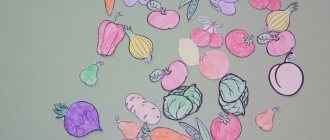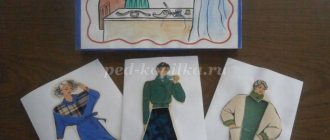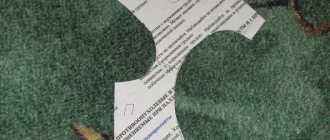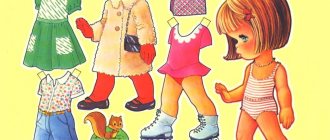Didactic games “Trees” in the younger group
We offer simple and exciting games that help younger preschoolers get acquainted with the world of flora.
One, two, three - hug the tree!
It is better to play outdoor games in a park where there are many different plants. The presenter names a tree of a certain type, says: “One, two, three - hug the tree!” Children look for the plant named by the leader, and when they find it, they run up to it and clasp it with their hands.
Find the odd one out
The game is designed to develop visual perception and observation skills. First hang natural objects that are not related to them on the plants growing in the yard. For example, on a birch - an acorn, on a fir tree - a maple leaf, on an oak - a pine cone. The task of preschoolers going out for a walk is to carefully examine the plants and find the odd one out.
Crafts
The activity develops imagination and creativity. For the game, collect natural materials: cones, fallen leaves, seeds, birch catkins, pieces of bark, acorns, maple “spouts”. Invite students to make crafts from the collected material. Each child creates some kind of appliqué, painting, three-dimensional composition. Then he tells what parts of the tree he used to create the artwork. At the end of the lesson, you can make an exhibition of children's works with discussion.
Wood parts
The activity develops memory and thinking abilities. Younger preschoolers will learn the names of plant parts.
Print out a realistic image of a tree, tell the children what a trunk, branches, roots are, explain that the collection of leaves is the crown. During the explanation, children should look at the picture.
Unlimited access to classes with online tutors
More profitable than paying for each lesson separately
The Ministry of Education is working on a unified approach to the prevention of deviant behavior in children
Reading time: 1 minute
At the new “Numbers Lesson,” schoolchildren will be told about game development
Reading time: 1 minute
Popova proposed changing the school biology curriculum
Reading time: 1 minute
The Ministry of Education is developing an educational minimum for teacher training
Reading time: 2 minutes
In Yakutia, schoolchildren were sent to distance learning due to frost
Reading time: 1 minute
Teachers are offered 1.5 million rubles to move to Zlatoust
Reading time: 1 minute
Gift certificates
Responsibility for resolving any controversial issues regarding the materials themselves and their contents is taken by the users who posted the material on the site. However, the site administration is ready to provide all possible support in resolving any issues related to the work and content of the site. If you notice that materials are being used illegally on this site, please notify the site administration using the feedback form.
All materials posted on the site were created by the authors of the site or posted by users of the site and are presented on the site for informational purposes only. Copyrights for materials belong to their legal authors. Partial or complete copying of site materials without written permission from the site administration is prohibited! The opinion of the administration may not coincide with the point of view of the authors.
Source
Didactic games "Trees" in the middle group
Games intended for the middle age group continue to introduce preschoolers to the signs and characteristics of different trees, foster curiosity, broaden their horizons, develop speech skills and the ability to think logically.
What grows on what?
The presenter begins the phrase, and the players logically continue:
- there are... apples hanging on the apple tree;
- there are... earrings hanging on the birch tree;
- there are... nuts hanging on the hazel tree;
- there are... acorns hanging on the oak tree;
- there are... pine cones hanging on the tree.
Make up a picture
For the game, prepare pictures depicting trees familiar to preschoolers, cut them into several arbitrary parts. Hand out the cut images to the children and ask them to put the parts of the picture together into a single whole. Having completed the task, the child carefully examines the picture, says what plant he sees, and describes it. For example: “This is oak. He's big and strong. This is a forest tree. There are acorns hanging on it.”
Guess by description
The presenter names a list of signs, and the children try to guess what plant they are talking about:
- slender, with a white trunk, with earrings, curly, thin - birch;
- prickly, triangular, covered with needles, with wide legs, green in winter - a Christmas tree;
- strong, with a thick trunk, with acorns on the branches, with a wide crown, centuries-old - oak;
- weeping, slender, with long branches, bending over the water - willow;
- beautiful in autumn, with large carved leaves - maple.
Say an adjective
The presenter says the name of the tree, and the players take turns calling the defining adjective:
- birch, and the sap... birch;
- pine, and the cone... pine;
- aspen, and the leaf... is aspen;
- oak, and the furniture... oak;
- poplar, and the fluff... poplar;
- bird cherry, and the color... bird cherry;
- apple tree, and jam... apple;
- linden, and honey... linden;
- spruce, and the paw... is spruce.
Good or bad
Have the players split into two groups. The first in line should name everything that benefits the trees. For example, watering, sun, rain, fertilizer, bees, heat. The latter call what is harmful to plants. For example, insects, fire, cold, frost, heat, drought. It is important that children explain their opinions in detail.
Didactic games “Trees” in the senior group
In the older group, preschoolers learn to distinguish, describe, classify, their ideas about the world around them expand, and speech skills develop.
Tell me about the leaf
The game teaches how to compose complex sentences; preschoolers' understanding of colors and shapes expands. For the activity, prepare dried leaves of different types of trees familiar to the children. Or print realistic images. Each student takes turns choosing the piece of paper that he likes more than the others and tries to describe it in detail.
Find a tree
It is better to play the game in a park where there are many different types of flora familiar to preschoolers. Children look at the plants around them, while listening carefully to the teacher. And he talks about the tree without naming it. Based on the description they hear, children must guess what plant they are talking about. For example, here is a description of the rowan: “A slender tree with long and narrow leaves, collected together in several pieces. In autumn, berry clusters form on the branches. The berries are small and red; bullfinches love to feast on them.”
I am a tree
Outdoor play promotes physical development, stimulates imagination, and broadens one's horizons. Before class, discuss with your students that trees come in different shapes and sizes: with a narrow and wide crown, with branches pointing up or down. Let the students imagine that they are trees: their arms are branches, their legs are roots, their torso is a trunk. Each child imagines himself to be a plant of a certain type, but does not say what kind.
Each player takes turns standing in front of his comrades, using gestures and body movements to depict the tree and what is happening to it. The other players guess what their friend is trying to show. For example, when imitating an oak tree, a child demonstrates that he is strong, spreads his legs, sticks out his chest, and makes sounds that imitate the rustling of leaves in the wind, the chirping of birds on the branches. When depicting a willow, the player makes a sad face, imitates crying, and limply lowers his hands.
What's extra?
The game teaches you to classify plants according to key characteristics. For the lesson, make cards, each of which should depict 4 types of trees, one of which belongs to another category.
Players look at the images one by one, identify the odd plant, and select a unifying category for the rest. If the player makes a mistake, the right to move is transferred to the next child. The one who correctly identified the extra tree gets a point. The winner is the one who scores the most points.
Here are examples for the game:
- maple, aspen, spruce, poplar - category of deciduous species;
- spruce, cedar, pine, chestnut - coniferous species;
- aspen, pear, cherry plum, apple tree - fruit crops;
- lilac, birch, jasmine, bird cherry - shrubs.
Fly to me, leaf
For active play, you need dried fallen leaves of different types and silhouette views of the same leaves. Players receive silhouettes one at a time. The teacher stands at the other end of the room and shows the dried leaves to the children. For example, he shows a maple leaf and calls: “Fly to me, maple leaf.” The player, who sees the corresponding outline, runs up to the teacher and talks about the features characteristic of the tree to which the demonstrated leaf belongs.
The game can be complicated by not naming the type of plant, but simply saying: “Fly a leaf to me.” Then the child, who has discovered the corresponding contour, must himself determine the species of the tree, then talk about it.
Trees (4 extra)
Description of the presentation by individual slides:
Slide description:
Speech therapist lessons The fourth wheel
Slide description:
Slide description:
Slide description:
Slide description:
Slide description:
Slide description:
Slide description:
Slide description:
Slide description:
Slide description:
Slide description:
Slide description:
Slide description:
Slide description:
Slide description:
Slide description:
If you believe that material violates copyright or for some other reason should be removed from the site, you can leave a complaint about the material.
Refresher course
Occupational Safety and Health
Professional retraining course
Library, bibliographic and information knowledge in the pedagogical process
Professional retraining course
Occupational Safety and Health
We are looking for teachers to join the Infourok team
Find material for any lesson by indicating your subject (category), class, textbook and topic:
You can also select the type of material:
general information
International Distance Olympiad Autumn 2021
Similar materials
Using the DragandDrop macro in the same presentation with triggers
Unusual computer peripherals
Loop statements in the Pascal ABC programming environment
Internet technologies in education
The amount of information as a measure of reducing knowledge uncertainty
Characteristics of the Information Society
Expanded form of the number. Converting a number from any number system to decimal
Windows Workflow Foundation 4.0
Didn't find what you were looking for?
Use the search in our database of 5319503 materials.
You might be interested in these courses:
Leave your comment
Log in to ask questions.
Didactic games “Trees” in the preparatory group
The presented games expand the understanding of plant species, develop imagination and thinking abilities, and form basic mathematical and lexical knowledge.
Trees
The purpose of the didactic game “Trees” is to get acquainted with the diversity of flora and teach the skill of identifying and distinguishing plants. The game is played in the form of a lotto, it requires 24 cards depicting different types of flora, and 4 playing fields, divided into 6 cells with images of the corresponding plants.
The presenter distributes the playing fields to the players. Then he shows the cards one by one and names the plant depicted. The child who finds the corresponding image on his field receives a card. The game ends when one of the players covers all the cells of the field with pictures, he becomes the winner. But before this, the player must name the category that includes the plants on his field. For example:
- aspen, poplar, maple, chestnut, linden, rowan - deciduous species;
- jasmine, lilac, sea buckthorn, hawthorn, bird cherry, mimosa - shrubs;
- spruce, cedar, juniper, pine, thuja, cypress - conifers;
- Apple, apricot, plum, cherry plum, pear, cherry are fruit crops.
Didactic game “Which tree is the leaf from?”
For the game, prepare cards on which trees of 4 different types are depicted at the top, and 4 leaves below them. For example, at the top are images of maple, aspen, birch, and rowan, and below them are aspen, rowan, maple, and birch leaves. Ask the student to correctly connect the plants with leaves: draw lines between them.
What is a tree?
The presenter begins a phrase on the importance of plants for living beings and people, and the players take turns continuing:
- a tree for birds is... a home, a resting place, a place to build a nest, a feeder;
- for painters - an artistic object, the basis of a landscape, an object of inspiration;
- for beetles - housing, food, place of laying eggs, place of hibernation;
- for travelers - a place of rest, protection from the scorching sun;
- for builders - material for building houses;
- for carpenters - material for making furniture.
Trees
The game is recommended not only for preschoolers in the preparatory group, but also for younger schoolchildren with speech impediments. For the lesson you need sets of cards of 4 categories: numbers from 1 to 10, two options for signs and the trees themselves. From the cards presented, the child makes sentences that he pronounces out loud. First, you should show your preschooler how to do this. The first card in a row is laid out with a number, then a picture of a plant, and at the end there are 2 cards with characteristics.
For example, a child posts the number 3 and a picture of an aspen tree. Pronounces: “Three aspens.” Between these cards he places symbolic images of the characteristics of the object: tall and slender. Says the full sentence: “Three tall slender aspen trees.”









